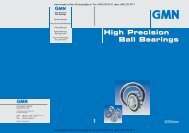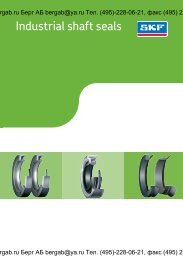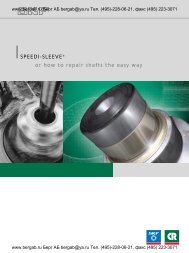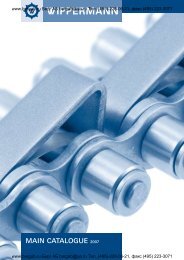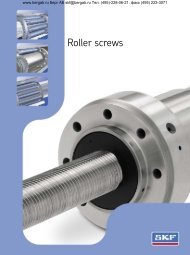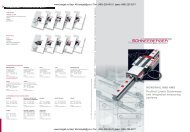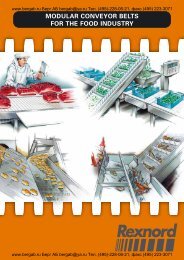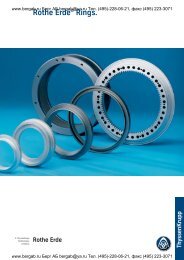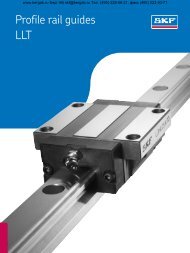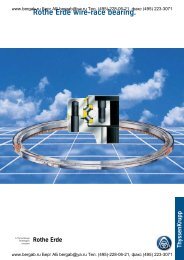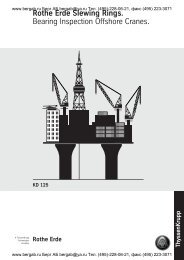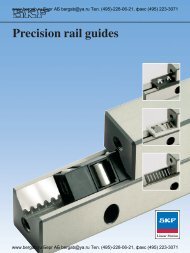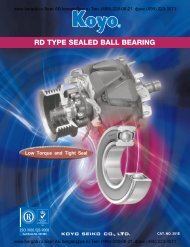Industrial shaft seals
Industrial shaft seals
Industrial shaft seals
Create successful ePaper yourself
Turn your PDF publications into a flip-book with our unique Google optimized e-Paper software.
gab.ru Берг АБ bergab@ya.ru Тел. (495)-228-06-21,<br />
<strong>Industrial</strong><br />
факс<br />
<strong>shaft</strong> <strong>seals</strong><br />
(495) 22<br />
Lubrication<br />
In order for a radial <strong>shaft</strong> seal to be able to<br />
seal efficiently over a long period it is<br />
necessary to lubricate the sealing lip. This<br />
prevents actual lip counter surface contact and<br />
reduces friction as well as wear to the lip and<br />
counter surface. Dry running of sealing lips<br />
made of standard materials should be avoided<br />
at all costs. Because of this, the counter<br />
surface should be coated with a suitable<br />
lubricant when the seal is being installed, so<br />
that the sealing lip is lubricated right from the<br />
beginning.<br />
The medium being sealed is not only<br />
intended to lubricate the seal but also<br />
transport the heat generated by friction in the<br />
lip/counter surface contact. Thus, the medium<br />
must be able to reach the sealing lip in<br />
sufficient quantities from the very beginning.<br />
In applications where the seal has to retain<br />
oil or grease, lip lubrication is not normally a<br />
problem. Some rolling bearings, e.g. angular<br />
contact ball bearings, taper roller bearings and<br />
spherical roller thrust bearings, as well as<br />
gears, have a pumping action by virtue of their<br />
design. This means that the sealing lip can<br />
either be starved of lubricant or be subjected<br />
to excessive quantities of lubricant. In both<br />
cases steps need to be taken at the design<br />
stage in order to ensure that lubricant actually<br />
reaches the contact, or that excess quantities<br />
are removed.<br />
Where lubricant starvation has to be prevented,<br />
lubrication ducts can be provided.<br />
Where there is too much lubricant, a flinger<br />
can be installed between bearing and seal.<br />
When lubricants are not being sealed,<br />
grease or oil must be supplied separately so<br />
that the lip can be lubricated. In exceptional<br />
cases and where <strong>seals</strong> with a secondary (dust)<br />
lip or two sealing lips are used it may be<br />
sufficient to provide an initial fill of grease<br />
between the two lips.<br />
Lubrication of paired arrangements<br />
If two radial <strong>shaft</strong> <strong>seals</strong> are to be mounted in<br />
a common housing bore either in tandem or in<br />
a back-to-back arrangement, care must be<br />
taken to see that neither of the sealing lips can<br />
run dry at any time. To eliminate any risk of<br />
dry running, the free space between the <strong>seals</strong><br />
or sealing lips should be filled with a suitable<br />
lubricating grease.<br />
To guarantee lubricant supply to the sealing<br />
lips in operation and to prevent dry running,<br />
the use of a spacer ring between the two <strong>seals</strong><br />
is recommended. This ring should be provided<br />
with lubrication holes or an annular groove<br />
and lubrication holes (fig 44), so that grease<br />
can be supplied to the space between the<br />
sealing lips, e.g. via a grease nipple.<br />
gab.ru Берг АБ bergab@ya.ru Тел. (495)-228-06-21, факс (495) 67 22<br />
Fig 44



